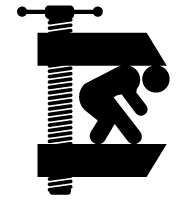
According to a recent report by the Center for Disease Control, more than 100 million people in the United States are diabetic or are prediabetic.
My dad is one of those people, recently diagnosed with Type 2 diabetes. He had been tipping closer and closer in his numbers over the years, and it seems that daily comforts of ice cream, Raisin Bran and processed foods have taken their toll. Or maybe it was that last slice of lemon meringue pie that put him over the edge.
After a lifetime of following a Standard American Diet (SAD) and recommendations that have put Type 2 Diabetes at epidemic levels in our country, my dad simply did not know what to eat. Everything he was consuming came from a restaurant, a fast-food place, or the frozen food aisles of the grocery store. It wasn’t for a lack of trying to eat right. Cheetos were “gluten free,” so they must be healthy. His doctor said to eat more eggs, so a breakfast burrito at McDonalds was the answer. Coffee was thick with white liquid poured from jugs of sweetened creamer, which was okay because it was “low fat.” Instead of pepperoni they ordered “veggie” pizza. Instead of the “dangerous” water from their tap, they drank fruit-flavored replacements.
After years of encouraging, guiding and suggesting how to eat healthier – with a bit of criticism from other family members of my healthier diet being “too extreme” – my dad is finally open to changing his diet. He has to. It’s now come down to a choice between a life of wheelchairs and pain, or a life of feeling great and staying active. After packing up his pantry and removing everything that has a lot of sugar in it, we now are restocking with better choices.
On the day I arrived to clean out his fridge and food storage (at his request), he was feeling overwhelmed – unsure what to eat or how to go about changing. To help, I created the diabetes diet food list below for him to use as a guide. And it’s not that he can NEVER eat things like cereal again, but when he does, it needs to be a treat, a cheat, or a true special occasion, and not too much.
Here is what I prepared for him. And not only are these designed to help as a diabetes diet food list to help you figure out what to eat to balance blood sugar and help you lose weight — they also serve as a diabetes diet guide that’s low carb, in case that’s something you’re looking for.
Diabetes Diet Food List
“YES, EAT THESE THINGS”
Base your diet on whole, unprocessed foods. Choose baked, broiled, boiled, steamed, roasted, smoked or poached (nothing fried or coated with flour or crumbs).
- Meat: Beef, chicken, turkey, pork, etc. Splurge on grass-fed, pasture-raised and organic when available. Always go for the least-processed option. Sausages and bacon (in moderation) should be uncured, nitrate-free and/or no sugar or corn syrup added.
- Fish and seafood: Salmon, walleye, swordfish, tuna, crab, shrimp, etc. Choose fresh and/or wild-caught when available.
- Eggs: Best to go for brown free-range or enriched eggs. Yes, they cost a little more, but you’re worth it.
- Vegetables: Taste the rainbow! Broccoli, asparagus, cabbage, spinach, peppers, onions, carrots, tomatoes, etc. Green beans and sugar snap peas are OK since they’re mostly pod. Look for “nutrient dense” foods — iceberg lettuce is NOT nutrient dense, so look for alternatives.
- Fruits: Apples, berries, bananas, oranges, pears, avocados, lemon, grapefruit, and more. No juice aside from a splash to flavor your water.
- Potatoes: White, yellow and red potatoes, sweet potatoes, yams — baked, boiled or mashed but NOT FRIED.
- Nuts: Almonds, cashews, pistachios, macadamia nuts, walnuts. Raw is best. Not sweetened (No honey roasted or coated if added flavor includes sugar or sweeteners.) No peanuts. No peanut butter. Switch to almond or cashew butter with no sugar or sweeteners added.
- Healthy fats and oils: Olive oil, coconut oil, avocado oil and ghee.
- Salt and spices: Sea salt, pepper, garlic, turmeric, rosemary — anything EXCEPT for those with sugar added. Read the labels of spice blends.
“NO, DO NOT EAT THESE THINGS”
A simple rule: If it looks like it was made in a factory, don’t eat it.
- No sugar and high-fructose corn syrup: Soft drinks, fruit juices, table sugar, candy, pastries, ice cream and many others. See list here.
- No grains: Includes breads and pastas, rice, wheat flour, whole grains, wheat, oatmeal, spelt, rye, barley, etc.
- No legumes: Beans, black beans, chickpeas, hummus, peanuts, lentils, etc. Green beans and sugar snap peas are OK since they’re mostly pod.
- No dairy: Avoid dairy except butter. Avoid low-fat. If you do eat dairy, it must be UNSWEETENED and FULL FAT. Swap out with coconut cream (sold by the can).
- No milk: Chocolate milk, whole milk, skim milk, 2% milk, sweetened and sugar-free coffee creamers. Choose heavy cream or an unsweetened “nut milk” instead (almond milk, coconut milk, cashew milk, etc.)
- No vegetable oils: Soybean oil, sunflower oil, cottonseed oil, corn oil, grapeseed oil, safflower oil and others.
- No trans fats: “hydrogenated” or “partially hydrogenated” oils.
- No artificial sweeteners: No blue, pink, yellow or white packets. Look for green. No aspartame, sucralose, cyclamates, saccharin, or acesulfame potassium. Use natural non-sugar sweeteners instead, like stevia and monk fruit.
- No highly processed foods, including any packaged “diet” foods. This includes artificial meal replacements.
As a marketer, I am convinced that the fantastic work of my friends in the industry has caused a level of confusion about food and nutrition that’s out of control. While everyone is trying to position and sell their product as the solution, they’re adding to the problem of noise and confusion for the rest of us when trying to figure out what to eat.
As I share this information, I implore you to GO TO YOUR DOCTOR, do the bloodwork and find out if you are among the 100 million who have a concern regarding insulin levels. And if you want to do a quick check, you can use this quiz the CDC offers to find out more: take the quiz.



